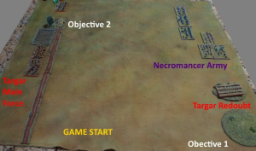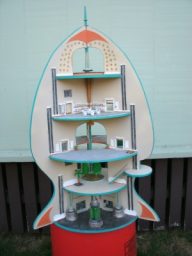Welcome to the Tabletop Officer Training Corps, Recruit
Saturday , 31, December 2016 Tabletop Games, Wargames 6 Comments
- is both a social and a solo hobby. To get the most out of miniature wargaming, you need to find opponents against which to war, but before you can match wits over a tabletop you have to spend some time alone reading rules, marshaling your forces, and preparing the field of battle.
- is both a rational and an emotional hobby. While the rules of the game and the history of the battles require thought and understanding, the heat of the battle and the discussions that revolve around them can generate significant emotions. Close games can feel as suspenseful as any Hitchcock film, and a man who refuses to admit that the brocage on the shoulders of his little tin men are the wrong shade of yellow can arouse the fiercest passion.
- provides an excuse to unleash your creativity, but can also demand rigid adherence to a strict code. The wide range of genres and theaters of war guarantees that the would-be miniature wargamer can find outlets for his imagination. Playing games set in realms of fantasy or science-fiction are the obvious subjects for creative types, but even the most staid wargamer who demands authenticity down to the smallest detail can exercise his imagination in planning raids and battles that fit within the historical record. On the other hand, a wargamer can spend a lifetime researching uniform details and orders of battle, and adhere to them all without once allowing a stray independent thought to enter his head.
As if all that variety wasn’t enough, miniature wargames are just plain fun.
HTML: <!–more–>Miniature wargames combine the sustained effort and great looking end-result of model rail-roading with the intellectual rigor of chess, and with the unpredictability, suspense, and free wheeling fun of a role-playing game. One blunder can turn the tide of battle. One die roll can determine the victor. And one evening at your painting station can keep your hands from turning into the devil’s playground while you turn your mind to deep thoughts, bad movies, or an audiobook from your favorite publisher.
Then there’s the investment in time, money, and space.
If you’ve ever thought about entering the tabletop wargame list, but been put off by the massive variety of games, the steep learning curve, or the daunting amount of time and money they seem to require, 2017 is the year you run out of excuses. Castalia House has been gracious enough to host a year-long series of posts that will guide you through the process from genre selection to hosting a convention game, one small step at a time. Starting this Wednesday and then posting semi-weekly, the information presented to the Tabletop Officer Training Corp will serve up a steady and methodical approach that you can follow along at home, one small step at a time. If you do, by the time next Christmas rolls around, you’ll have your very own complete wargame custom made by you, for you! You will also have seen a lot of other ideas that you didn’t have time to fully explore, or you will be motivated to move on to bigger and better wargames like the one shown above.

Two massive armies prepare for battle.
Even if you’ve never felt the call of miniature wargame duty, this series will provide a more detailed look at a hobby world that most fantasy and sci-fi enthusiasts have encountered, and quite possibly demonstrate how the overlap between this hobby and literature can be as wide as that between tabletop role-playing games and literature.
You grognards* out there have been through this process often enough that your problem isn’t starting the hobby, but finishing a project. Every wargamer has a big pile of unpainted figures that they have collected and not yet gotten around to painting yet. They purchase a unit here to add to this game, and then a figure there to add to the RPG collection, and before they know it, they have a lead mountain – more miniatures waiting for paint than they could complete in a lifetime. Following along with a project like this might just help remind you that the play is the thing, and show you how one guy manages to stay focused on one project at a time.
Welcome to the Tabletop Officer Training Corp, recruit. I’ll be your instructor. And who am I? What makes me think that I’ve got the chops to turn a raw recruit like you into the next tabletop Clausewitz?

Meet my 2012 project – a detailed pulp rocketship for 15mm sci-fi figures to fight over.
Not only have I been a miniature wargamer for more than 30 years, I’ve organized and run several long-running miniature campaigns involving up to a dozen factions, organized gaming conventions (hat tip to Marmalade Dog, still running strong), and currently run a popular wargame blog called War in A Box. I’ve seen action in every conflict, from the wars of antiquity to the conquest of the Aztecs to the Age of Reason to the Pacific Theater of Operations, and from Middle Earth to galaxies far, far away. I’ve run games in every scale from 6-mm to 54-mm and from individual combat all the way up to massed blocks of troops. In short, I’ve seen the miniature elephant.
Now you get to take advantage of all those years of experience. Stick with me, follow along, and I’ll show you an engaging step-by-step process that will have you wargaming in no time, and that will help you put together a complete, inexpensive, attractive, and portable game. This process won’t require massive amounts of time, money, or effort, but will serve as a launching pad that you can build on to your heart’s content.
This coming Wednesday, we’ll introduce the wargame that I will be using to illustrate how to build your own wargame. We will also cover the wide selection of games available, show you where to buy the rules and figures, and provide some guidance on selecting a game that can be built, painted, understood, and run without a demotivational amount of time or effort.
*”Grognard” is a slang term for old wargamer, and was taken from the French term for “grumbler”. The (possibly apocryphal) origin of the term comes from soldiers of the original imperial guard created by Napoleon.
Corps, maybe?
Excellent, I shall look forward to this series.
Looking forward to the series and like the figures at the War in a Box blog.
Interesting. I like your Pulp rocketship.
